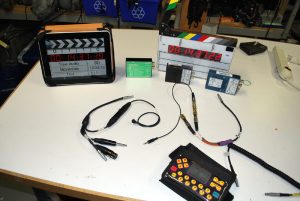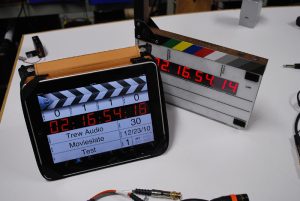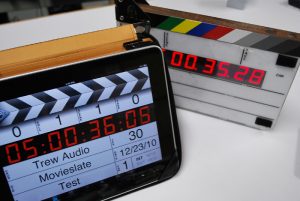A Syncing Feeling with Software
With the recently released Clockit Timecode App iDevice software from Ambient, the MovieSlate app and editing software like PluralEyes, the production world is buzzing with questions. Is it safe to use? Should I get rid of my clapper slate? What are the features & benefits, advantages & disadvantages? Hopefully, this article will help address some of those issues and help you make a more informed decision.
What does the software do?
Well, it decodes a timecode signal (READ: does not generate) and displays the timecode in both its digits and waveform and also shows you the userbits and frame rate. It also gives you a meter to view your input signal and how hot (or not) it may be. For right now, with Clockit Version 1.14, that’s it. Future upgrades are planned including freeze/log button, stopwatch, Clockit ALL log tables, cue sheets for sound, continuity, etc.
How does this help you?
The big bonus here is that it displays the incoming timecode from a hardwired device (syncbox, slate, wireless receiver). If you’re using any generator without a display (i.e. Ambient ACL boxes, Denecke SB boxes) then you can actually see the timecode the box is generating. For now, it’s a fun device for a script supervisor or continuity editor. It could be used as a visual timecode reference a camera can shoot but there is no clap to indicate absolute frame. However, editors should be able to see a single frame for reference.
Cables?
These iDevices need a cable to hardwire them to your timecode source. You can make your own, or, if you’re not great with a solder gun, consider buying the Ambient cables or Remote Audio’s iDevice Timecode cables.
The wiring diagram for this is cable is available right from Ambient’s webpage.
Below is the basic information on iDevice wiring for an input – the microphone input is on the sleeve. Also note, this is not your standard 3.5 TRS connector but a 3.5 TRRS connector.
- 1 Tip Left audio
- 2 Ring Right audio
- 3 Ring Common/Ground
- 4 Sleeve Microphone
(the connector is available from some cell phone places, well stocked Radio Shacks or online at Mouser)
Is it safe to use?
Well, drop an iDevice and your chances of it surviving aren’t the best. Will a producer pay for a busted slate, yes (they should anyway)–An iPad is another thing entirely. Granted, Otterbox makes a very durable iPad case (and they claim it’s drop proof) to at least increase your chances.
Of course, no app would be complete without a heaping pile of competition.
MovieSlate, in my humblest of opinions, is the closest we’ll get currently to real advancement over your classic slate. Again, I won’t say it absolutely will replace a slate for a few reasons, let’s get into it all.
MovieSlate is the app that looks more like an actual slate. It behaves like one as well. If you tap the sticks (which you can select from about 8 different colour combinations) the slate will “clap”. You can easily enter all the slate face information -scene, take, INT, EXT, Frame rate, date, etc. by selecting the specific box. The keyboard pops up and you punch in the information. You can add producer and director straight from your contact database. The takes increment with a quick touch (or automatically), no dry erase – marker – dry erase needed (unless you want to ruin your iDevice). You can sync via wifi or Bluetooth to other iDevices). You can even sync timecode with your iTunes music to your choice of frame rate! It’s a beautiful thing for music video playback.
The biggest feature (and the best for the location sound person’s purposes) are the sound reports or shot logs. Write notes (or punch in “snippets” like airplane, wild track, MOS, etc.), take photos of your location (so they can see the generator sitting beside the set), use the GPS technology to map your location (so they know you’re on a beach) and record voice notes. You can rate the audio and video on a 5 star rating. You can save all the data, search through it and if you change productions, save its whole history and swap between multiple shoots. The nicest feature of all is at the end of the day, email the information out to all the appropriate parties (that of course are in your contacts database) in whatever format post wants (Final Cut XML, HTML, CSV, or tab-delimited format) based on the DAW they’re using. No more paper! It’s all saved on a hard drive and emails to prove they received it!
Oh, and it’s only $20. But for an additional $50, you buy their PRO version which allows you to input timecode. I like to think we operate in a professional world where the “you get what you pay for” adage holds true. If a syncbox generator is roughly $600-$1000 from companies we’ve always trusted for reliability then is $50 going to keep sync as accurately? Well, an iPhone for instance gets its timecode from your service provider or network who gives you the time from an atomic clock. Google atomic clock “started operating in 2004 at an uncertainty of one second in 30 million years” and well, that sounds pretty accurate to me.
Here’s more information on MovieSlate.
Our Research
Problem:
Can an app developed for iDevices actually replace a timecode slate?
Procedure:
Using an Ambient Master Clock as our master we jammed the iPad’s movie slate app, Ambient ACL203, Denecke SB3, Denecke SB-T and a Denecke TS-3 slate.
Observations:
In the first half hour, the movie slate app seems to have drifted off by about 2 frames.
2 hours after, the movie slate app seems to have maintained the 2 frame drift.
5 hours after, the movie slate app seems to have drifted by about 7 frames.
Conclusion:
For the price, it’s good enough for Jazz. For absolute times and accuracy, I wouldn’t recommend jamming it and relying on it unless you want an angry post supervisor. Also, you may need anti glare in the daylight. The big drawback is the brightness settings only go so high vs. what you get on a classic slate. The further you get from the camera with the iPad, the less the camera will read the numbers. In a darkened studio, no problem, daylight – there’s limitations in the iPad. The run time on an iDevice battery is not as long as a classic slate. Six hours if the screen is constantly backlit but certainly a production day if you’re letting it darken (does not affect timecode). Again, it’s not as rugged and certainly doesn’t look or feel “professional.”
The times they are a changin’ though and we all know it. Maybe it will become more of standard, and Ambient jumping on board the app train is a good sign of better things to come. I spoke with Charlie at Denecke and he’s been working on an app for quite some time and just hasn’t released it as yet.
So, how does it work for guys that need something and really do see the advantages here?
Well, are the post houses ready for emailed sound reports? I think they’d welcome it. You just need a Syncbox so it can be your absolute clock and it needs to stay hardwired (much like the older slates with an SB-2A stuck on the back of it and the slate just displaying the timecode). What’s cool is that you can enter all the information you want from the app (user bits, start code, etc) and send it to the sync box, then reverse the procedure and jam everything out of the sync box back into the app.
Another small mention, given the title of the article, should be given to PluralEyes. It’s the FCP/Vegas plugin software that can sync audio to video without the use of timecode. It does this by syncing the waveforms of the audio files and the video files. The catch here is that the audio on the camera and the audio recorder should match. Do your best to send a scratch track wirelessly to the camera to make the sync function better. If the camera has its own mic, it might not match what you’re recording so well, thus, making the software irrelevant. Read more about PluralEyes software.
Maybe the biggest concern here–your iPad should never be a game or a toy. We’re professionals. I highly recommend making the device running the software a device used solely for the purpose of your work much like other software (Metacorder or Boom Recorder)does. The word “standalone” is a serious one. It’s why Sound Devices, Zaxcom and Fostex exist – to be standalone work horses for audio. They don’t use a processor to update a facebook status or tweet that they just recorded the 100th file of the day.
It’s your choice–you decide the risk level. At least, now you have a few more options to consider.
7 comments
Leave a reply Delete Message
You must be logged in to post a comment.






Thank you Tyler for an excellent article. I especially appreciate your tests with the MovieSlate app, it's good to know the limitations.
I have a feeling that we will begin to see more TC products in the near future, with pricing not necessarily in the $80 range, but also not as extreme as $2,000 for a smart slate.
A little self-promotion: having had the need for a simple bright TC display in a bag for documentary style shoots, I am in development stages on a very small TC display that will be perfectly suited for such purposes. The people I am working with are under www.betso.cz and there are several other interesting TC products from them that might be of interest to many audio professionals.
Thomas Hayek, Toronto
hey Tyler,
thanks for helping us explore the options available in terms of software slates. i do share your opinion that for now, movie slate seems like the most advanced software option. did anyone ever tested using the movie slate app as a wi-fi timecode transceiver from a stable clock (sound devives 744t by example). then in editing room, comparing on image timecode display from ipad to timecode value on video and finally timecode value on audio.
basically i want to know if the wi-fi process is fast enough to make it frame accurate.
i do not think that these apps should be considered for their timecode generating purposes as described in the test. but if this works, i can see myself using these things ( with external extra batterie packs and proper shock/rain protection )
thanks again,
Dominique
btw the remote control of slate in the movie slate app is a pretty practical function not to be forgotten
Um, why not use that iPad for all the things it does? The technology is there, it's solid, stable, why not use it? Why are some devices one trick ponies? Cause they were made that way, and are not real computers, like an iPad is.
Great article. I use Movie Slate all the time and love it.
And be sure to check out the Alesis StudioDock Pro!
I would like to say that these applications are very intriguing, but I have instantly found some problems with MovieSlate that should be stated and separately verified.
To be absolutely fair, I have been in contact with PureBlend software and have found them quick to respond and open to suggestions and discussion and they immediately passed on the Apple refund procedure. I have great hopes for this, or other apps, especially since GPS is now the recommended time transfer standard of the US Naval Observatory, which keeps THE clock. Imagine if all those DSLR jockeys just showed a little accurate time of day to the camera, wouldn't that make us all feel better?
PureBlend's MovieSlate does not support 23.97. It's on the app setup window, but plugging it into my FR-2, it generated invalid timecode indicators using their pro upgrade. Pureblend confirmed my concerns and promised to correct their website. All you Canon DSLR users should take strict note and should understand that 24p1080 on these cameras is actually 23.97, depending on firmware revisions and Magic Lantern. Most people may have not experienced a lot of problems given a good grab of absolute frames early in the roll, but when multiple cameras are being serviced and the 12 minute mark happens and operators start recycling their cameras, you are already out 10 frames. DOH!
Secondly, the music video app breaks LTC for the duration of the after slate freeze frame. Yikes.
Finally, the music video mode only supports 29.97DF with valid code, which pretty much nixxes crossjamming as well for your longer tunes.
This app is so potentially amazing, but for my jobs, it ain't quite there. I am told it will get better.
I have been using the Ambient Clockit app for a while and one thing I have noticed which hasn't been mentioned here is that the app cannot display frame accurate code, it only shows one in every two or three frames which can even result in 26 frame seconds being displayed
In some cirucmstances a frame or two may not be a big deal but of course sometimes accurate frame for frame matching is essential
I am still looking to find out if this is a limitation of the phone/tablet itself or the Ambient app - note that this app has been tested in several different models of iPhone and with different mchines generating the code and always results with the same problem occuring
I wonder if anyone could confirm this same problem occurs with MovieSlate or the LTC Reader app?
I certainly think there is a future for products like these but would agree that they should be run on standalone machines and, personally, would always feed them from a dedicated, accurate generator and use the phone/pad simply as a dumb reader (and leave it permamnently connected to avoid the dreaded drift!!!!!!!!)
Cheers
Hello,
how do you feed the Ipad/Iphone movie slate pro?
What is the correct wiring? Can I use the ambient cable lemo5 to jack TRRS?
Thank you.
Yes, The ambient cable will work.
Remote Audio also manufactures cables for the Iphone/Ipad that can be found here: http://www.remoteaudio.com/cables_adapters/idevice/